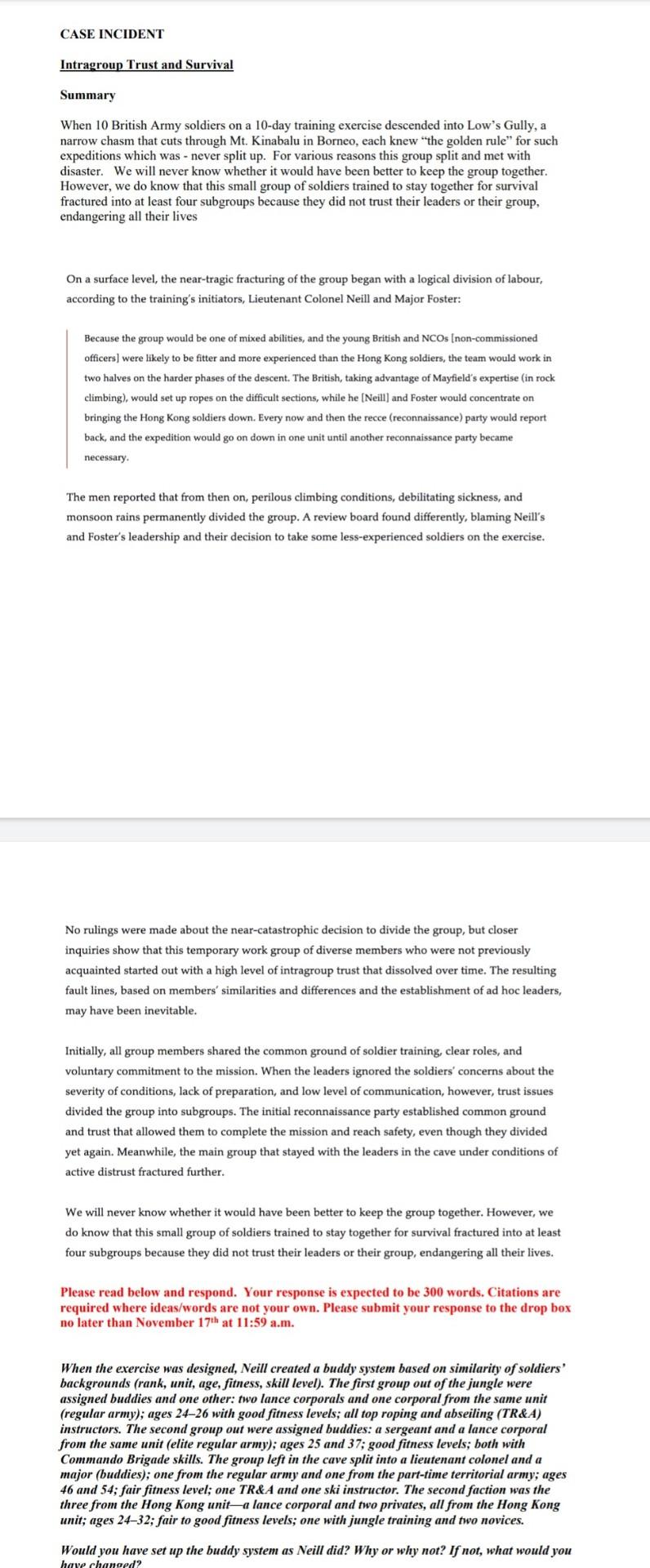Answered step by step
Verified Expert Solution
Question
1 Approved Answer
Hey stranger, I need your original ideas in it .Please do not copy from other chegg answer or from google as many people do it.I

Hey stranger, I need your original ideas in it .Please do not copy from other chegg answer or from google as many people do it.I will report you if you copy content. I believe in you and I will give you upvote if i get satisfaction. Take your time I'm not in hurry.
CASE INCIDENT Intragroup Trust and Survival Summary When 10 British Army soldiers on a 10-day training exercise descended into Low's Gully, a narrow chasm that cuts through Mt. Kinabalu in Borneo, each knew the golden rule" for such expeditions which was - never split up. For various reasons this group split and met with disaster. We will never know whether it would have been better to keep the group together. However, we do know that this small group of soldiers trained to stay together for survival fractured into at least four subgroups because they did not trust their leaders or their group, endangering all their lives On a surface level, the near-tragic fracturing of the group began with a logical division of labour, according to the training's initiators, Lieutenant Colonel Neill and Major Foster: Because the group would be one of mixed abilities, and the young British and NCOs (non-commissioned officers) were likely to be fitter and more experienced than the Hong Kong soldiers, the team would work in two halves on the harder phases of the descent. The British, taking advantage of Mayfield's expertise (in rock climbing), would set up ropes on the difficult sections, while he (Neill) and Foster would concentrate on bringing the Hong Kong soldiers down. Every now and then the recce (reconnaissance) party would report back, and the expedition would go on down in one unit until another reconnaissance party became necessary The men reported that from then on, perilous climbing conditions, debilitating sickness, and monsoon rains permanently divided the group. A review board found differently, blaming Neill's and Foster's leadership and their decision to take some less-experienced soldiers on the exercise. No rulings were made about the near-catastrophic decision to divide the group, but closer inquiries show that this temporary work group of diverse members who were not previously acquainted started out with a high level of intragroup trust that dissolved over time. The resulting fault lines, based on members' similarities and differences and the establishment of ad hoc leaders, may have been inevitable. Initially, all group members share the common ground of soldier training, and voluntary commitment to the mission. When the leaders ignored the soldiers' concerns about the severity of conditions, lack of preparation, and low level of communication, however, trust issues divided the group into subgroups. The initial reconnaissance party established common ground and trust that allowed them to complete the mission and reach safety, even though they divided yet again. Meanwhile, the main group that stayed with the leaders in the cave under conditions of active distrust fractured further. We will never know whether it would have been better to keep the group together. However, we do know that this small group of soldiers trained to stay together for survival fractured into at least four subgroups because they did not trust their leaders or their group, endangering all their lives. Please read below and respond. Your response is expected to be 300 words. Citations are required where ideas/words are not your own. Please submit your response to the drop box no later than November 17th at 11:59 a.m. When the exercise was designed, Neill created a buddy system based on similarity of soldiers' backgrounds (rank, unit, age, fitness, skill level). The first group out of the jungle were assigned buddies and one other two lance corporals and one corporal from the same unit (regular army); ages 2426 with good fitness levels; all top roping and abseiling (TR&A) instructors. The second group out were assigned buddies: a sergeant and a lance corporal from the same unit (elite regular army); ages 25 and 37; good fitness levels; both with Commando Brigade skills. The group left in the cave split into a lieutenant colonel and a major (buddies); one from the regular army and one from the part-time territorial army; ages 46 and 54; fair fitness level; one TR&A and one ski instructor. The second faction was the three from the Hong Kong unita lance corporal and two privates, all from the Hong Kong unit; ages 2432; fair to good fitness levels; one with jungle training and two novices. Would you have set up the buddy system as Neill did? Why or why not? If not, what would you have changedStep by Step Solution
There are 3 Steps involved in it
Step: 1

Get Instant Access to Expert-Tailored Solutions
See step-by-step solutions with expert insights and AI powered tools for academic success
Step: 2

Step: 3

Ace Your Homework with AI
Get the answers you need in no time with our AI-driven, step-by-step assistance
Get Started


